According to UNESCO, only 28% of people engaged in scientific research worldwide are women. Even in a professional field such as science, which brings about progress by its very nature, a deep abyss of gender persists, and not even those states with the greatest social development have managed to be free of it. For example, in Sweden the majority of university students are women, at 61%, but the proportion declines to 49% in doctoral studies and 37% in research. Those regions with the most scientific strength, such as North America and Western Europe (32% of researchers), do not fare better than other emerging ones, such as Latin America and the Caribbean (44%).
Nor is it unusual that the names of female scientists are less well known to the public, especially when one takes into account, as an illustrative example, that only 17 women have received Nobel prizes in science from 1901 to 2015. One of them, the French-Polish Marie Curie, is among the four distinguished people holding two awards, and is probably the most popular female scientist. But beyond the famous discoverer of polonium and radium, there is a whole cast of women pioneers of science that managed to expand our knowledge and make their way in a world dominated by men. On International Women’s Day, we remember five brilliant examples.
Merit Ptah (c. 2700 BC)
Several references cite the Egyptian physician Merit Ptah as the first woman scientist whose name is known today. She would have lived around the year 2700 BC, which would place her in the Second Dynasty in the Archaic Period of Ancient Egypt. However, the references are somewhat unclear; some speak of an alleged inscription on a tomb in the Valley of the Kings, which is an anachronism since this place did not begin to be used as a necropolis until the sixteenth century BC, some 1,200 years later. More plausible is another version that places it in the necropolis of Saqqara, near ancient Memphis, and which did serve as a burial site from the First Dynasty.
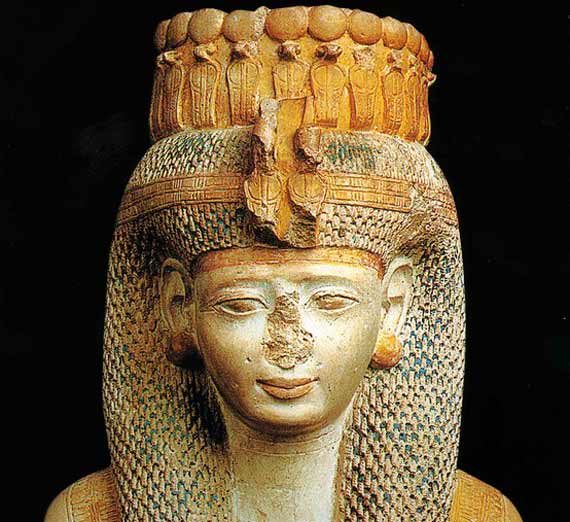
Merit Ptah was not an exception in her time; women practiced medicine in Ancient Egypt, many of them specializing in obstetrics. Perhaps the name of Merit Ptah was preserved because her son was a high priest and left written reference to her as “chief of physicians.” As for dates, Merit Ptah vies for seniority with Imhotep, the polymath who designed the Step Pyramid of Saqqara and who is often considered the first scientist whose name is known. This symbolic title could be claimed for Merit Ptah, whose name today designates an impact crater on Venus.
Emilie du Châtelet (1706-1749)
The Marquise du Châtelet, born Gabrielle Émilie Le Tonnelier de Breteuil, was predestined to a court life by the position of her father, chief of protocol of the Sun King, Louis XIV of France. Within this destiny came a marriage of convenience to a military man, which earned her the title of marquise. But from childhood a future in science seemed to be in the cards; the story is told that at the age of three a servant fashioned a doll for her by dressing up a large wooden compass. Émilie accepted the gift, but stripped the compass of its clothes and began to draw circles with it.
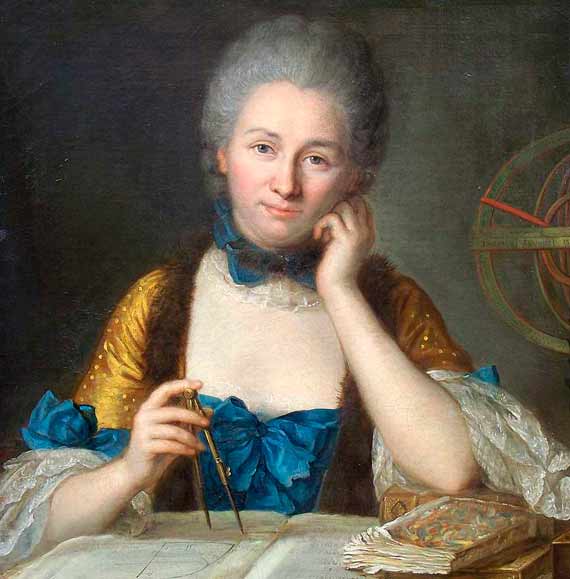
Du Châtelet fulfilled her role as a wife, giving birth to three children, but thereafter she was given over to science in body and soul. In body, because of her love affair with Voltaire, who was installed in her home with the consent of her husband, who was always away on campaign. The two lovers together cultivated their passion for knowledge, and even competed for a prize from the Academy of Paris with individual essays on the nature of fire. Du Châtelet’s work was the first by a woman to be published by the French Academy.
Du Châtelet contributions were numerous, but she is mostly remembered for her French translation of the Principia Mathematica by Isaac Newton, to which she added comments such as an innovative concept of the conservation of energy. Voltaire wrote that she was “a great man whose only fault was being a woman,” and because of this condition she died, due to complications after the birth of her fourth child.
Caroline Herschel (1750-1848)
The Herschel surname is historically linked to astronomy. William Herschel is known worldwide as the scientist who discovered the planet Uranus. His son, John, continued his astronomical work and cultivated other sciences. But there was a third member of the family, often unjustly forgotten – Caroline, William’s sister.
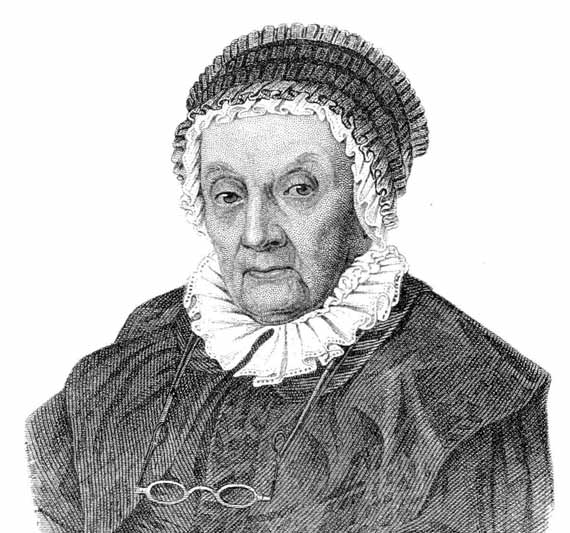
Like other women scientists, Caroline Herschel had to deal with very adverse circumstances and a destiny already written, in her case that of Cinderella. Due to an illness she suffered as a child, her height stayed at just one meter thirty. Assuming that she would never marry, her parents raised her for domestic service. When her father died, her brother William, having emigrated from his native Germany to England, invited her to settle with him to look after his house. She did so, and incidentally learned the profession of her brother, which at that time was not astronomy, but singing.
William spent his spare time manufacturing telescopes and observing the firmament, and eventually, Caroline joined him. She was the first woman to receive a pension from the British Crown as a scientist, the first to see her work published by the Royal Society, and the first to discover a comet as well as numerous groups of stars and nebulae. Interestingly, she never learned to multiply and always carried a sheet with multiplication tables in her pocket.
Mary Somerville (1780-1872)
The story of Scottish Mary Fairfax begins like so many other women in the affluent society of her time; there were dances and social gatherings, a parent who opposed her studies and a marriage to a distant cousin, Samuel Greig, who also opposed her studies. But a key fact in her life was that her husband would only live for three more years, allowing her to finally pursue her studies.

Mary Somerville, whose surname was taken from her second husband, was a polymath, and studied mathematics, physics and astronomy. She translated into English the celestial mechanics of Laplace, to whom she once remarked that there were only three women who understood his work: her, Caroline Herschel and a Mrs. Greig; the Frenchman had no idea that the third woman was also her. Somerville was associated with some of the leading scientists of her time. She influenced James Clerk Maxwell and suggested the existence of Neptune, which John Couch Adams would later prove mathematically. She was the tutor of Ada Lovelace, daughter of Lord Byron, who worked with Charles Babbage on the early computing machines.
Somerville was one of the first two women, along with Caroline Herschel, to be admitted to the Royal Astronomical Society. Today she is remembered as one of the greatest woman scientists in history, perhaps the most important, since her work also led to the term by which all her colleagues have been known ever since. It was in a review of her work On the Connexion of the Physical Sciences where, in 1834, William Whewell coined the term scientist to refer to those who hitherto had been called “men of science” or “natural philosophers”.
Mary Anning (1799-1847)
Unlike other scientists of her time, men or women, Mary Anning did not have a settled lifestyle. For her, collecting fossils was not a hobby, but rather an activity through which her father supplemented his meager income as a carpenter, selling the pieces he found to tourists. When the father died, the family had to survive on charity. Mary and her brother Joseph, the only survivors of ten siblings, continued to risk their lives in search of fossils in the dangerous cliffs of Dorset. On one occasion, Mary nearly died from a landslide that took the life of her dog, Tray.
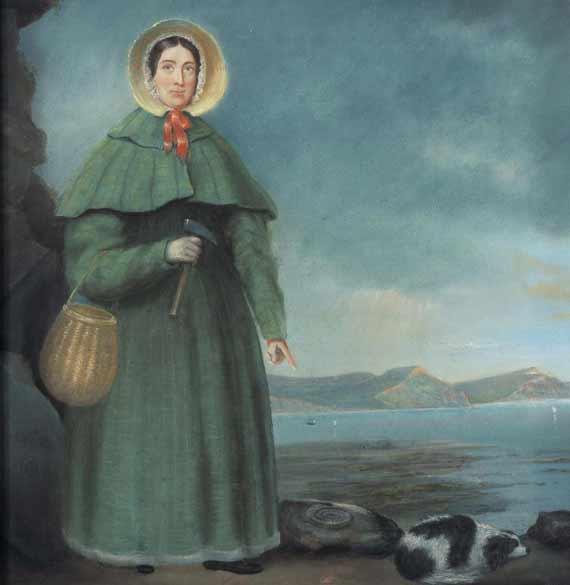
One day, Mary and Joseph discovered a strange specimen that looked like the fossil of a crocodile. It turned out to be an ichthyosaur, the first to be recognized as such. On her own, Mary Anning would discover the first plesiosaurs and the first pterosaur outside of Germany, among other important findings, which led her to be dubbed “the greatest fossil hunter the world has ever known.” When geologist Henry De la Beche painted Duria Antiquior, the first realistic depiction of prehistoric life, it relied mainly on the fossils discovered by Anning.
Mary Anning never had access to scientific training. She used to sell her pieces to renowned experts, so she scarcely received any credit for her findings. It mattered little that scientists travelled from America to consult with her. She was never admitted to the Geological Society of London, and her only work published in life was a letter to the editor of the Magazine of Natural History. In her epoch it was difficult for a woman to make headway in the world of science, but to be like Anning, poor as well as female, was a sentence that limited her general recognition until after her death.
Maria Gaetana Agnesi (1718-1799)
In the past, those who devoted their lives to science often came from wealthy families, but on the Italian Maria Gaetana Agnesi fell all the gifts of life. She was born into a wealthy family in Milan, was very beautiful according to her contemporaries, and had an unparalleled brain: by age 11 she spoke seven languages, and a few years later was able to discuss convoluted philosophical topics with the guests gathered by his father, a professor of mathematics at the University of Bologna.
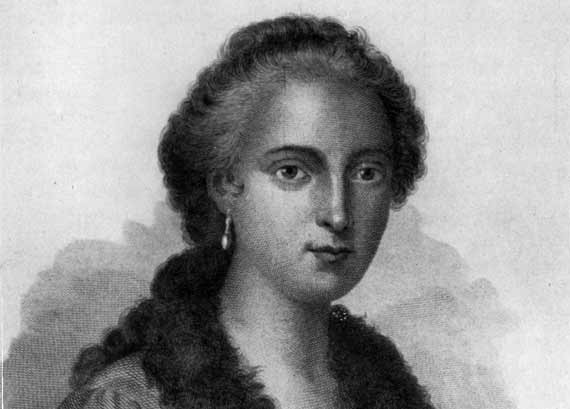
Agnesi also practiced this discipline, while educating her 20 siblings and half-brothers that the three marriages of his father came to gather under one roof. Her most outstanding work was Instituzioni analitiche ad uso della gioventù italiana (Analytical Institutions for the Use of Italian Youth), a volume published in 1748 which dealt with differential and integral calculus. The book contains her most famous contribution, the curve called the Witch of Agnesi. The name is the product of a mistranslation; the mathematician Guido Grandi had called this curve versoria, the Latin name for a sheet, a rope used on sailing ships. Its Italian version was versiera, a word that was also used as a shortened form of avversiera, meaning devil or witch. In the English edition of the book it was translated as witch, and has remained like that.
But despite her many gifts, triumphs and titles, including being the first female professor of mathematics in history, Agnesi was not satisfied with a life served on a platter. Deeply Catholic, she traded her success for voluntary poverty and a life devoted to serving the poor and sick, while at the same time studying theology. Her final years were spent cloistered and serving the elderly in a Milan hospice, where she died as a nun and a pauper.
Nettie Stevens (1861-1912)
To define the essence of the biologist Nettie Maria Stevens (July 7, 1861 – May 4, 1912) it’s sufficient to note two facts: first, she discovered that sex is determined by chromosomes and, second, despi
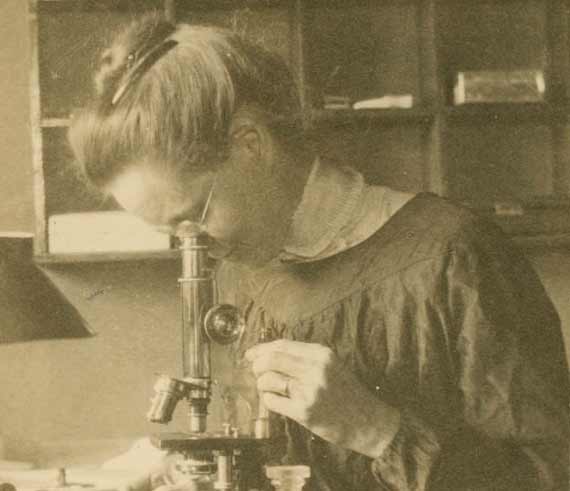
Her outstanding intelligence was recognized, but not her achievements. While searching for the key to determining the sex of a species, which at the time was attributed to environmental factors, Stevens found that male flour beetles had an “extra” chromosome that was shorter; today we know this as the Y chromosome. In 1905, Stevens wrote that this difference was responsible for the determination of sex. That same year, Edmund Beecher Wilson published a similar idea, although hisinsects lacked the Y chromosome.
However, both Wilson and Thomas Hunt Morgan, Stevens’ supervisor, were not convinced that environmental factors did not have some influence. To demonstrate that sex depended only on chromosomes, Stevens studied the cells of 50 species of beetles and nine of flies. But when cancer took her in 1912, she had not yet managed to impose her vision, and most of the recognition went to Wilson. Nowadays, Stevens’ work has been vindicated, to which one curiosity must be added: Morgan, who won the Nobel prize in 1933, is considered the founder of genetic studies with the fruit fly Drosophila melanogaster, used today by thousands of researchers. But the person who first brought this species to Morgan’s lab was a female student of his named Nettie Stevens.
Maria Mitchell (1818-1889)
The case of Maria Mitchell (1 August 1818 – 28 June 1889) reminds us of the many brilliant minds that have been lost to science for the mere fact of having belonged to women who lacked opportunities. Mitchell is the counterexample: she did have opportunities and she took great advantage of them. Although she was raised in traditionalist New England, the equality between the sexes upheld by her family opened the door to studies that would lead to a brilliant career in astronomy.
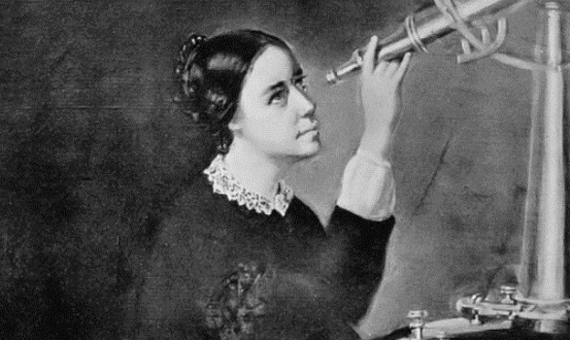
Even as a child, Mitchell collaborated with her father, who was a teacher and fond of observing the sky. At age 14, the precocious young scientist assisted the navigation of the whalers of her native island of Nantucket (Massachusetts) with her calculations. On 1 October 1847, although still an amateur astronomer, she became the third woman to discover a comet. Her discovery, today called C/1847 T1, earned her a gold medal from the King of Denmark, brought her unexpected fame and helped her to become the first female professional astronomer in the USA, head of the Observatory of Vassar College in New York.
Mitchell was a woman of ideas ahead of her time. As a curious example, she gave up wearing cotton clothes as a protest against slavery. But above all, she was an active supporter of women’s rights, promoting the suffrage movement and the participation of women in science. Nevertheless, a thorn remained in her side: she never married or had a partner, a price that many women scientists have had to pay in exchange for a career and prestige. During a trip to Europe, she wrote her admiration for the Scottish astronomer and mathematician Mary Somerville, about whom she said: “The hours of devotion to close study have not been incompatible with the duties of wife and mother.”
Comments on this publication